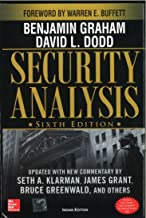Book Summary of Security Analysis
by Benjamin Graham, David L. Dodd

About the Book:
"Security Analysis: Principles and Techniques" by Benjamin Graham and David L. Dodd is a foundational text in the field of value investing. Originally published in 1934, it has been updated multiple times, with the seventh edition including contemporary insights from leading investors like Seth Klarman. The book provides an in-depth exploration of the principles and techniques required for analyzing securities, emphasizing the importance of intrinsic value and offering detailed methodologies for evaluating stocks and bonds. It is widely regarded as the "bible" of value investing, teaching readers how to assess financial statements, value businesses, and avoid speculative pitfalls.
Who Should Read the Book:
This book is essential reading for serious investors, financial analysts, and students of finance who wish to understand the rigorous process of security analysis. It is particularly suited for those interested in value investing, offering a deep dive into the methodologies that have influenced generations of successful investors, including Warren Buffett. Given its complexity and depth, it is most beneficial for those with a strong foundation in finance or investing.
10 Big Ideas from the Book:
- Intrinsic Value: The concept that each security has an inherent value based on its fundamentals, which may differ from its market price.
- Margin of Safety: Investing with a cushion by purchasing securities at a significant discount to their intrinsic value to minimize risk.
- Investment vs. Speculation: A clear distinction between buying assets based on careful analysis (investment) versus attempting to profit from market fluctuations (speculation).
- Financial Statement Analysis: Detailed techniques for analyzing income statements, balance sheets, and cash flow statements to assess a company's financial health.
- Market Inefficiencies: Recognition that markets are not always efficient, and mispricings offer opportunities for value investors.
- The Role of Psychology in Investing: Understanding that investor behavior can lead to irrational decisions and market inefficiencies.
- Bond and Preferred Stock Analysis: In-depth examination of fixed-income securities, focusing on safety and yield.
- Earnings Power and Growth: The importance of evaluating a company's ability to generate sustainable earnings over time.
- Qualitative Analysis: Beyond the numbers, assessing the quality of management, industry position, and other intangible factors.
- Long-term Focus: Emphasizing patience and the importance of a long-term investment horizon to realize the benefits of value investing.
Summary of Part I: Survey and Approach
Part I of "Security Analysis: Principles and Techniques" lays the foundation for the entire book, introducing key concepts and setting the stage for more detailed analysis in later parts. This section is crucial for understanding the overarching principles of security analysis and value investing as conceived by Benjamin Graham and David Dodd.
Important Takeaways from Part I:
- Intrinsic Value is Key: Understanding and calculating the intrinsic value of a security is essential for successful investing.
- Investment vs. Speculation: A disciplined approach to distinguishing between investment and speculation can protect investors from unnecessary risks.
- Comprehensive Analysis: Both quantitative and qualitative factors must be considered in security analysis to make well-rounded investment decisions.
- Use Reliable Information: Investors must base their decisions on accurate and reliable data to avoid the pitfalls of misinformation.
Key Ratios to Remember from Part I:
- Price-to-Earnings (P/E) Ratio: A measure of the price paid for a share relative to the income or profit earned by the firm per share. It helps in assessing whether a stock is overvalued or undervalued.
- Dividend Yield: This ratio indicates how much a company pays out in dividends each year relative to its share price. It is calculated as the annual dividend per share divided by the price per share.
- Intrinsic Value vs. Market Price: The difference between the intrinsic value of a security and its market price is central to making investment decisions. The exact calculation of intrinsic value can vary but typically involves evaluating a company’s assets, earnings, and future prospects.
Summary of Part II: Fixed-Value Investments
Part II of "Security Analysis: Principles and Techniques" focuses on fixed-value investments, particularly bonds and other fixed-income securities. This section is essential for understanding the principles of selecting and analyzing these types of investments, which are characterized by their relatively stable returns and lower risk profiles compared to equities.
Important Takeaways from Part II:
- Focus on Safety: The primary concern when investing in bonds and fixed-value securities is the safety of principal and interest payments. Investors should seek a strong margin of safety in all fixed-income investments.
- Strict Selection Criteria: Graham and Dodd advocate for a disciplined approach to bond selection, with rigorous standards for financial health, earnings stability, and asset protection.
- Importance of Ratios: Various financial ratios are essential tools for assessing the safety and viability of bond investments. Coverage ratios, asset coverage, and liquidity ratios are particularly important in evaluating the risk associated with bonds.
Summary of Part III: Senior Securities with Speculative Features
Part III of "Security Analysis: Principles and Techniques" delves into senior securities that possess speculative features, such as convertible bonds, preferred stocks with warrants, and other hybrid securities. This section is crucial for understanding the risks and rewards associated with these types of investments, which lie somewhere between traditional fixed-income securities and common stocks in terms of risk.
Important Takeaways from Part III:
- Understanding Privileges and Risks: Senior securities with speculative features offer potential rewards but come with additional risks compared to traditional bonds or preferred stocks. Understanding the technical aspects, such as convertibility and warrants, is crucial for assessing these securities.
- Complexity Requires Caution: The added complexity of these securities, such as the interaction between their fixed-income and equity features, necessitates a careful and informed approach to investing. Investors must be diligent in analyzing the specific terms and conditions of each security.
- Speculative Nature: Securities discussed in Part III are inherently more speculative than traditional bonds or preferred stocks. As such, they are suited for investors who have a higher risk tolerance and are comfortable with the potential for significant volatility.
- Key Ratios are Essential Tools: Ratios like the Conversion Ratio, Yield to Call, and Conversion Premium are essential for evaluating the value and risk of these securities. Investors must be familiar with these metrics to make informed decisions.
Summary of Part IV: Theory of Common-Stock Investment. The Dividend Factor
Part IV of "Security Analysis: Principles and Techniques" shifts the focus from fixed-income securities and senior securities to common stocks. This section explores the principles of investing in common stocks, emphasizing the role of dividends and the factors that influence common-stock valuation. It is a critical part of the book for understanding the principles behind value investing in equities.
Important Takeaways from Part IV:
- Dividends as a Key Component: Dividends are an essential aspect of common-stock valuation. They provide a direct return to shareholders and reflect a company's ability to generate cash flow and maintain profitability.
- Intrinsic Value Focus: As with other securities, the intrinsic value of common stocks should be the primary focus of analysis. Investors should be wary of paying inflated prices for stocks based on speculative future earnings, especially in growth stocks.
- Growth vs. Value: Graham and Dodd highlight the risks associated with overpaying for growth stocks. They emphasize that even for companies with high growth potential, there should be a margin of safety to protect against unforeseen setbacks.
- Comprehensive Analysis: Investors should evaluate both earnings and dividends when analyzing common stocks. A strong earnings record and a stable or growing dividend are indicators of a potentially valuable investment.
Key Ratios to Remember from Part IV:
- Price-to-Earnings (P/E) Ratio: An essential measure of whether a stock is overvalued or undervalued relative to its earnings. Lower P/E ratios are generally more attractive, but the context of the company's growth and industry should also be considered.
- Dividend Yield: Provides insight into the income return from dividends relative to the stock price. Higher yields can be attractive, but they must be weighed against the sustainability of the dividend.
- Price-to-Book (P/B) Ratio: Helps assess the market's valuation of the company's assets relative to its book value. A lower P/B ratio may indicate an undervalued stock, while a higher ratio may suggest a premium is being placed on the company's assets.
- Price-to-Earnings Growth (PEG) Ratio: Adjusts the P/E ratio for earnings growth, providing a more nuanced view of valuation relative to expected growth. A PEG ratio below 1 is generally favorable.
- Dividend Payout Ratio: Indicates the proportion of earnings paid out as dividends. A balanced payout ratio reflects a company’s strategy of rewarding shareholders while retaining earnings for growth.
- Dividend Coverage Ratio: Measures the ability of a company to sustain its dividend payments. A ratio above 1 is desirable, indicating earnings are sufficient to cover dividends.
Summary of Part V: Analysis of the Income Account. The Earnings Factor in Common-Stock Valuation
Part V of "Security Analysis: Principles and Techniques" focuses on the analysis of the income account, with particular emphasis on the role of earnings in the valuation of common stocks. This section is crucial for understanding how earnings, a primary driver of a company's value, should be analyzed and interpreted when making investment decisions.
Important Takeaways from Part V:
- Focus on Earnings Quality: Analyzing the income account is crucial for assessing the quality and sustainability of a company’s earnings. Investors should be diligent in adjusting for non-recurring items and accounting artifices that can distort true earning power.
- Importance of Stability: Consistent and stable earnings are a positive indicator of a company’s long-term financial health. Volatility in earnings should be a red flag, prompting further investigation.
- Capitalization and Earnings: Understanding a company’s capitalization structure is essential for evaluating its ability to generate sustainable earnings. A balanced structure reduces risk and enhances earning potential.
- Caution with Speculative Stocks: Low-priced common stocks often carry significant risk, and investors should be particularly cautious, focusing on the quality and sustainability of income sources rather than speculative price movements.
Key Ratios to Remember from Part V:
- Gross Profit Margin: Indicates efficiency in production and sales. Higher margins suggest better profitability.
- Operating Margin: Measures the proportion of revenue left after covering operating expenses, reflecting core profitability.
- Adjusted Earnings Per Share (EPS): Provides a clearer picture of recurring profitability by removing extraordinary items.
- EBITDA: Offers a measure of overall financial performance, excluding non-cash charges.
- Earnings Stability Index: Measures consistency of earnings over time; lower values indicate more stable earnings.
- Adjusted P/E Ratio: Adjusts for changes in capitalization, ensuring accurate comparisons.
- Debt-to-Equity Ratio: Provides insight into financial leverage; lower ratios indicate more conservative structures.
Summary of Part VI: Balance-Sheet Analysis. Implications of Asset Values
Part VI of "Security Analysis: Principles and Techniques" focuses on balance-sheet analysis and the implications of asset values for investors. This section is vital for understanding how to assess a company's financial position through its balance sheet, which provides a snapshot of its assets, liabilities, and equity. By analyzing these elements, investors can gauge the financial stability and intrinsic value of a company.
Important Takeaways from Part VI:
- Book Value as a Baseline: Book value, while not always indicative of intrinsic value, serves as a useful baseline for evaluating a company’s financial health and providing a margin of safety.
- Liquidity is Crucial: The analysis of current assets, especially through liquidity ratios like the current and quick ratios, is essential for assessing a company’s ability to meet short-term obligations and maintain financial flexibility.
- Liquidation Value as a Floor: Liquidation value provides a minimum valuation floor, particularly in distressed situations, helping investors understand the potential downside risk.
- Adjusting for Intangibles: Not all assets on the balance sheet are created equal. Adjustments for intangible assets and careful analysis of tangible book value provide a more realistic view of a company’s asset base.
Key Ratios to Remember from Part VI:
- Price-to-Book (P/B) Ratio: A lower P/B ratio may indicate an undervalued stock relative to its book value, while a higher ratio may suggest overvaluation.
- Equity Ratio: Higher equity ratios suggest greater financial stability and less reliance on debt.
- Current Ratio: A measure of liquidity, with values above 1 indicating that a company has more current assets than current liabilities.
- Quick Ratio: A stricter liquidity measure that excludes inventory, with values above 1 preferred for indicating strong liquidity.
- Net Working Capital: An estimate of a company's liquidating value, important in assessing financial flexibility and distress scenarios.
- Liquidation Value Per Share: Provides a worst-case scenario valuation for a stock.
- Debt-to-Equity Ratio: A key measure of financial leverage, with lower values indicating a more conservative balance sheet.
- Tangible Book Value Per Share: A conservative measure of a company’s asset value per share, excluding intangibles.
Summary of Part VII: Additional Aspects of Security Analysis. Discrepancies Between Price and Value
Part VII of "Security Analysis: Principles and Techniques" addresses various additional aspects of security analysis, with a particular focus on identifying discrepancies between the market price of securities and their intrinsic value. This section delves into advanced topics that help investors recognize and exploit market inefficiencies.
Important Takeaways from Part VII:
- Exploiting Market Inefficiencies: Identifying and taking advantage of discrepancies between price and intrinsic value is a cornerstone of value investing. Investors should remain vigilant for opportunities where the market misprices securities.
- Importance of Comparative Analysis: Comparing companies within the same industry can provide valuable insights into relative valuation and operational efficiency, helping investors identify the strongest candidates for investment.
- Focus on Intrinsic Value: While market analysis can be helpful in the short term, the focus for long-term success should remain on intrinsic value and the underlying fundamentals of the business.
- Discipline and Patience: Value investing requires patience and discipline, especially when waiting for the market to correct price discrepancies. A margin of safety is crucial to protect against unforeseen risks.
Key Ratios to Remember from Part VII:
- Warrant Coverage Ratio: Helps assess the potential dilution from warrants, with higher ratios indicating greater potential impact.
- Warrant Premium: A lower premium suggests a better value proposition for investors holding or considering warrants.
- Weighted Average Cost of Capital (WACC): Lower WACC indicates more efficient financing, crucial for evaluating the cost-effectiveness of a company’s capital structure.
- Return on Invested Capital (ROIC): Higher ROIC indicates effective use of capital by management, reflecting better overall company performance.
Referenced Books:
"Security Analysis" itself has become a reference for many other investment books. However, within this book, earlier editions of "Security Analysis" (First Edition, 1934; Second Edition, 1940; etc.) are frequently referenced as foundational texts. Additionally, Graham's other famous work, "The Intelligent Investor," is often mentioned for its complementary insights into investment philosophy.
Browse Summaries of Top Investing books!
You may also like the below Video Courses



